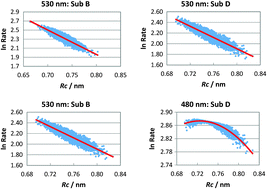Classification of the mechanisms of photoinduced electron transfer from aromatic amino acids to the excited flavins in flavoproteins†
Abstract
In many flavoproteins photoinduced electron transfer (ET) efficiently takes place from aromatic amino acids such as tryptophan or tyrosine to the excited isoalloxazine, so that the fluorescence lifetimes of isoalloxazine in some flavoproteins become ultrashort. The mechanism of ET in the flavoproteins was classified into four classes from the relationship between logarithmic ET rates (ln Rate) and the donor–acceptor distances (Rc), using reported data. The physical quantity, GT, is defined as the sum of solvent reorganization energy, electrostatic energy between a donor cation and an Iso anion, the standard free energy gap between the photoproducts and reactants, and net electrostatic energy between the photoproducts and other ionic groups in the flavoproteins (NetES). When GT fluctuates around zero with Rc, the ET rate becomes fastest (faster than 1 ps−1) in Kakitani and Mataga rates. In the ultrafast ET processes, the ln Rate becomes a parabolic function (category 1) of Rc as in FMN binding proteins and pyranose 2-oxidase at the shorter emission wavelengths, when NetES is negligible compared to the other quantities in the GT function. In the ultrafast ET processes, the ln Rate does not display any clear function of Rc (category 2) when NetES is dominant in the GT function, because of no direct relation between NetES and Rc. ET in flavodoxin from Helicobacter pylori may be classified into category 2. When GT linearly varies with Rc around a certain positive value, the ET rates become much slower (<1 ps−1). In this case the ln Rate linearly decreases with Rc (category 3), as Tyr224 in D-amino acid oxidase dimers. It is also conceivable that the ln Rate decreases with much scattered function of Rc (category 4), when NetES is dominant in the GT function, as Tyr314 in D-amino acid oxidase dimers. In ET processes of category 1, ET rates decrease as Rc becomes shorter than the distance at the maximum values of ln Rates, where GT is negative. Conditions and physical meanings were discussed for the GT-negative region.


 Please wait while we load your content...
Please wait while we load your content...